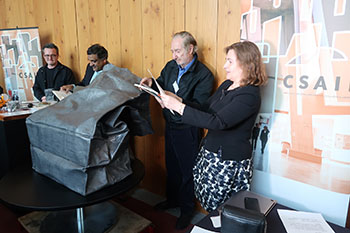CSAIL unseals time capsule with internet and computing artifacts

Researchers found plenty of tech-history relics inside the 20-year-old capsule.
Adam Conner-Simons | CSAIL
MIT’s Computer Science and Artificial Intelligence Laboratory (CSAIL) recently unsealed a special time capsule from 1999 after a self-taught programmer from Belgium solved a puzzle devised by famed cryptographer, EECS faculty member, and Institute Professor Ron Rivest.
Designed by architect Frank Gehry, the capsule was first created as part of a celebration commemorating 35 years of research at what was then MIT’s Laboratory for Computer Science.
CSAIL director Daniela Rus, Andrew (1956) and Erna Viterbi Professor of EECS, unveiled the capsule with former lab directors Anant Agarwal (an EECS faculty member and CEO of edX) and Ed Fredkin. The three then uncovered the artifacts locked inside like a group of giddy schoolchildren opening Christmas presents.
Among the items contained in the capsule:
- The original 1992 proposal for the World Wide Web developed by Tim Berners-Lee, now a MIT professor.
- Microsoft’s first-ever product, the Altair BASIC interpreter, which was donated by Microsoft founder Bill Gates, who attended the 1999 ceremony and helped fund the Stata Center building that CSAIL calls home.
- The 1979 user manual for VisiCalc, the first spreadsheet program, developed by MIT alumni Bob Frankston and Dan Bricklin. VisiCalc later spurred Microsoft to create it own version, called Excel.
- The 1978 paper that laid out the framework for RSA encryption algorithms, devised by Ron Rivest, Adi Shamir and Len Adleman, which are what enable modern e-commerce.
- A 1962 technical paper on MIT’s “Compatible Time-Sharing System”, one of the world’s first systems that allowed multiple people to use a computer at the same time.
Rus noted that there are still quite a few time capsules all over MIT’s campus — some buried, others hidden, and a few that are actually right in plain sight. For example, 80 years ago, MIT engineers placed a capsule under an 18-ton magnet in the cyclotron building. The capsule will be unearthed in the coming months as the Institute prepares to break ground for the new College of Computing building there.
Meanwhile, in 2015 a construction team working on the new MIT.nano building inadvertently uncovered a glass time capsule that was buried almost 60 years earlier, with the intention that it not be opened for 1,000 years.
Media Inquiries
Journalists seeking information about EECS, or interviews with EECS faculty members, should email eecs-communications@mit.edu.
Please note: The EECS Communications Office only handles media inquiries related to MIT’s Department of Electrical Engineering & Computer Science. Please visit other school, department, laboratory, or center websites to locate their dedicated media-relations teams.